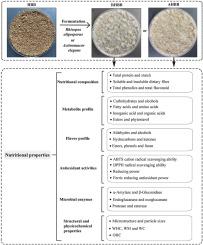真菌发酵改善高原大麦麸的营养质量、风味特征和理化特性
IF 3.9
2区 农林科学
Q2 FOOD SCIENCE & TECHNOLOGY
引用次数: 0
摘要
高地大麦麸(HBB)是高地大麦碾磨过程中产生的一种副产品,目前尚未得到充分利用。本研究利用食品级真菌 R. oligosporus 和 A. elegans 来改善 HBB 的食品质量。在发酵过程中,大分子营养物质被转化为小分子物质,并通过扫描电子显微镜(SEM)、粒度和代谢物分析进行了进一步鉴定。不溶性纤维被有效地生物转化为可溶性形式,从而显著改善了麦麸的理化特性,包括持水性、持油性、水溶性和膨胀能力。由于真菌酶释放的酚类物质增加,因此真菌发酵也增强了六溴代二苯的抗氧化活性。SPME-GC-MS 分析表明,由于醇类、烃类和酯类的增加,真菌发酵显著改善了六溴代二苯的风味。此外,寡孢子菌(R. oligosporus)发酵倾向于释放酚类物质,以获得较高的抗氧化活性;秀丽隐杆线虫(A. elegans)发酵倾向于改善理化性质,以提高六溴代二苯的加工适用性。总之,益生真菌发酵能显著提高六溴代二苯的食品质量和加工适用性,这意味着发酵六溴代二苯在开发功能食品方面具有很大的应用潜力。本文章由计算机程序翻译,如有差异,请以英文原文为准。

Fungal fermentation improves the nutritional quality, flavor characteristic and physicochemical property of highland barley bran
Highland barley bran (HBB), as a by-product during the milling of highland barley, is under-utilized. Food-grade fungi R. oligosporus and A. elegans were used in this study to improve the food quality of HBB. Macromolecular nutrients were converted into small molecules during fermentation, which was further identified by scanning electron microscope (SEM), particle size, and metabolite analysis. The insoluble fibers were effectively bio-transformed into the soluble form, inducing significant improvements in the bran's physicochemical properties including water-holding capacity, oil-holding capacity, water solubility, and swelling capacity. The antioxidant activity of HBB was also enhanced by fungal fermentation due to the increased phenolics released by fungal enzymes. SPME-GC-MS analysis demonstrated that the HBB's flavors were significantly improved by fungal fermentation due to the increased alcohols, hydrocarbons, and esters. Additionally, R. oligosporus fermentation tended to release phenolics to achieve high antioxidant activities, and A. elegans fermentation preferred to improve physicochemical properties to enhance the processing applicability of HBB, which were mainly due to their individualized metabolic pathways triggered during fermentation. In conclusion, fermentation with probiotic fungi significantly improved the food quality and processing applicability of HBB, implying a high application potential of fermented HBB to develop functional foods.
求助全文
通过发布文献求助,成功后即可免费获取论文全文。
去求助
来源期刊

Journal of Cereal Science
工程技术-食品科技
CiteScore
7.80
自引率
2.60%
发文量
163
审稿时长
38 days
期刊介绍:
The Journal of Cereal Science was established in 1983 to provide an International forum for the publication of original research papers of high standing covering all aspects of cereal science related to the functional and nutritional quality of cereal grains (true cereals - members of the Poaceae family and starchy pseudocereals - members of the Amaranthaceae, Chenopodiaceae and Polygonaceae families) and their products, in relation to the cereals used. The journal also publishes concise and critical review articles appraising the status and future directions of specific areas of cereal science and short communications that present news of important advances in research. The journal aims at topicality and at providing comprehensive coverage of progress in the field.
 求助内容:
求助内容: 应助结果提醒方式:
应助结果提醒方式:


